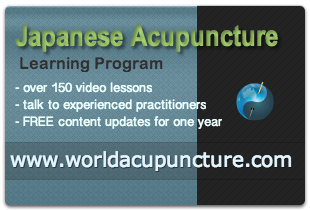Please read my reply to a pertinent question regarding sterilization and Japanese Acupuncture from Mark in Tennessee.
Greetings Mark,
Thank you for your continued interest and commitment to the practice of Traditional Acupuncture.
I hope all goes well for you and yours.
I can only answer your question from my recent experience in Ikeda sensei’s clinic.
He uses an autoclave for each and every guide tube after use and also for silver needles.
I believe the stainless steel needles are single use only.
I am converting back to the metal guide tubes from the plastic pre packed ones.
There is no doubt in my mind that the metal tubes are far more effective in eliciting specific responses when needling, especially in the root treatment and scatter needling techniques.
It feels very much like the guide tube becomes an extra instrument and provides a far superior connection with the patient.
I will be using these guidelines, as used for tattooists in the states for sterilizing the guide tubes and needle trays.
Autoclave Sterilization Guidelines
It is generally accepted that an autoclave chamber must reach at least 121°C at 15 psi for a minimum of 30 minutes to ensure adequate sterilization. Sterilization time may vary, however, depending on the quantity and density of items in the autoclave chamber. Bags packed to capacity will not receive adequate steam penetration even if typical autoclave parameters are observed. Since autoclave bags are impervious to steam, bags must be kept open to ensure steam penetration deep into the load. Adding one cup water to each bag of solid material helps ensure heat transfer to the items being sterilized.
Autoclave indicator tape and autoclave indicator bags change color when the proper temperature has been reached. The problem with this type of check is that the indicator is on the surface of the load – a positive reading does not ensure that the innermost parts of a large load have been sterilized. A quick check for steam penetration inside a load can be performed by wrapping an item (e.g., a disposable plastic test tube or pipette tip) with autoclave tape, attaching a string to the item, and putting it toward the center of the load. This should be done as the load is being generated. Do NOT open a load of potentially infected material to bury something inside. Recover the indicator after the run, and confirm that it has changed color.
While the indicator tape quick-check should be conducted with every load, it must be supplemented periodically by use of a biological indicator (such as Bacillus stearotherrnophilus) buried in the center of a load to confirm that the autoclave use parameters are bringing about sterilization. If either check fails, the autoclave must be examined to determine the problem and the problem repaired, or the operating parameters must be adjusted (such as increasing run times) so that load sterilization can be confirmed.
All of my needles are single use only.
I have recently purchased http://www.pressurecooker.com.au/go-85/Pressure_Cookers/KUHN_RIKON_Duromatic_Ergo_-_5L_pressure_cooker to assist in sterilizing tubes and trays.
Please note that:
I do not re use any instruments that penetrate the skin.
I hope my reply helps and I wish you all the best in practice.
Thanks again for your continued interest.
Kind Regards,
Alan
Below is a short video of my best impression of tonifying scatter needling as applied in patients with Yang deficient conditions
Alan Jansson is an internationally recognized teacher and practitioner of Traditional Japanese Acupuncture. For well over a decade, independent of and in conjunction with Masakazu Ikeda sensei and Edward Obaidey, Alan has presented, convened and hosted in the vicinity of 30 Traditional Japanese Acupuncture workshops in Australia, New Zealand and USA. Driven by a strong desire to promote the consumer friendly nature, clinical efficacy and potency of Meridian Based Traditional Japanese Acupuncture, Alan is a staunch advocate of practically based workshops and draws upon his 25 years clinical experience and 14 years post and undergraduate teaching in a concerted effort to lift the bar globally in the clinical application of this most amazing medical art.
Join him in Exploring the Art of Acupuncture in the 21st century at http://www.Worldacupunctureblog.com
For more info, please visit: http://www.Worldacupuncture.com

Speak Your Mind